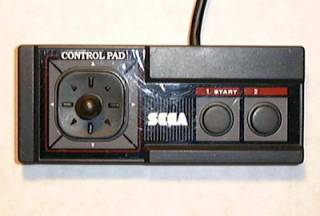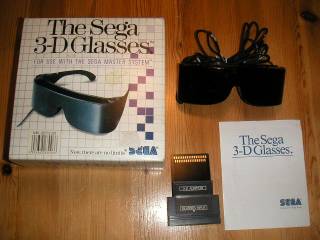Overview
 The gamepad.
The gamepad.The Sega Master System is an 8-bit cartridge and card based console released in 1985 for Japan, 1986 for North America, 1987 for Europe, and 1989 for South America. It is based off the Mark III release of Sega's first entry into the Japanese console market, the SG-1000. It competed directly alongside the Nintendo Entertainment System during its heyday, and it was supported by Sega well into the 1990's. The console usually featured a built-in game, such as Hang-On, Space Harrier, a timed maze game featuring a snail, Alex Kidd in Miracle World, Sonic the Hedgehog, or Sonic the Hedgehog 2.
The system has 2 9-pin controller ports, with each controller having 2 buttons (labeled 1 and 2) and an 8-way directional pad, created largely due to Nintendo's copyright of their cross bar pad, which caused the SMS controller to have more pronounced diagonals than their competition, but smaller N, S, E, and W controls. The pause button is located directly on the console.
While the Master System didn't challenge Nintendo much in the US and Japan, it was a major success in Europe and South America, outselling the NES in those territories. This gave Sega a good foothold in the home console market, which they capitalized on with their more successful follow up, the Sega Genesis. The Master System was still selling in Europe into the late 1990s, and is still selling through to the present day in Brazil, where it remains the best-selling console to this day. The Master System sold 16.39 million units worldwide, including 1.72 million in Japan, 2 million in the United States, 5 million in Brazil, 6.95 million in Western Europe, and 720,000 in South Korea.
The Master System's software library was limited in North America and Japan due to Nintendo's restrictive third-party licensing policies, for which the console has been criticized by the North American press. However, the system's reception was far more positive in Europe and South America, regions where Nintendo's restrictive third-party licensing policies did not apply. As a result, the Master System's software library in Europe and South America was significantly larger and more diverse, whereas it was the NES which had a more limited software library in those regions.
Launch
Japan - October 20, 1985
North America - June 1986
Europe - Fall 1986
Peripherals
Further information: SegaScope 3-D Glasses and Power Base Converter
 The 3D glasses.
The 3D glasses. The Light Phaser.
The Light Phaser.Early models of the console shipped with a Safari Hunt/ Hang On card, one game pad and one light phaser. Missile Defense 3D also made use of the console's SegaScope 3D glasses, which plugged into a card slot device and saw only six games made for it since release. The glasses plugged into a card slot device and used shutters to simulate 3D depth from flickering images on screen. An arcade stick was also released as a peripheral, and a six-button version of the game pad appeared later in the console's life.
Sega released an add-on for the Genesis called the Power Base Converter that sat on top of the cartridge slot and allowed for Master System games to be played on the 16-bit console. It has all of the exterior features of the original Master System including a pause button on the device and support for both cartridges and cards.
The Light Phaser was was a light gun required to play Safari Hunt and would go on to be featured in games such as Shooting Gallery and Missile Defense 3D.
Technical Specifications
 Sega Control Stick
Sega Control Stick- CPU: 8-Bit Zilog processor running at 3.579545 MHz
- Memory: 64 Kb RAM
- Video: Texas Instruments VDP, 256 x 192 or 256 x 224 resolution, 32 colors on screen (16 for sprites/background, 16 for background only) from a palette of 64
- Sound: Texas Instruments 4 channel processor (3 Square Wave, 1 White Noise)
Built-in Games
The Sega Master System (depending on the model) came with one, two, or three games built into its hardware. For the model 1 Sega Master System, the machine pre-programmed with three games. The actual retail quality games were Hang On (Action) and Safari Hunt (Light Phaser Series). However, there is a special exclusively programmed meta-mini-game hidden in the Master System hardware. It is a Snail Maze game that can be accessed through holding both the one and two buttons as well as holding the up potion of the directional square.
Software Formats
 Sega Handle Controller
Sega Handle ControllerThe Sega Master System had multiple forms of solid state software technology that was made compatible for the system. The machine allowed for cartridges in the Mega-Cartridge series. For example, the game Alex Kidd in Miracle World was a Mega-Cartridge game, but later and more advanced games like After Burner used the Four Mega-Cartridge technology. It is unknown at this point if the Sega Master System cartridge technology surpassed the Four-Mega Cartridge. However, there is another variation on this form of software; the implementation of a lithium battery (exactly the same as batteries used for computer motherboards). This addition is indicated with the cartridge suffix descriptor of "Plus" or plus battery aided rewritable memory storage. For example, Phantasy Star is classified as a Four-Mega Plus Cartridge. The Plus feature allowed for players to record scores and game progress.
Another form of game media for the Sega Master System also had support for game card or "Sega Cards." These were credit card sized solid state form of media that were fed into their own dedicated input slot on the system and tended to be ports of games from Sega's older Japanese console titles. The appeal of this software format was that they held less (only 34KB of space), game cards ended up being cheaper than Sega's Mega Cartridge games. One of the best titles on the Sega Card media is Transbot. It is important to note that the two later model designs of the Sega Master system omit a game card input slot.
Log in to comment